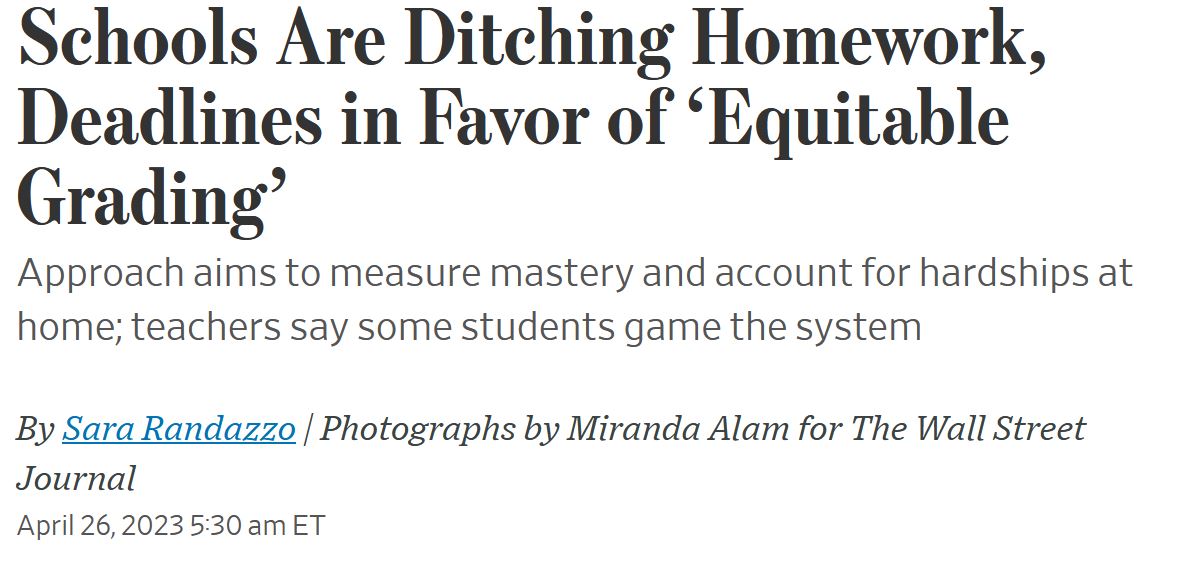
Equitable grading is just another way to lie about education. Some students will learn more and some will learn less. If grades mean anything, they should reflect a student’s demonstrable ability. Making excuses for students of unfortunate background doesn’t change their demonstrable ability.
Soon after the system was introduced, however, Ms. Penrod said her 11th-grade honors students realized the new rules minimized the importance of homework to their final grades, leading many to forgo the brainstorming and rough drafts required ahead of writing a persuasive essay. Some didn’t turn in the essay at all, knowing they could redo it later.
Of course. People who don’t teach smart students forget that they are smart. In AP Physics, most of my students had ACT scores in the 30’s. They will figure out the system, and maximize the cost/benefit ratio.
Google Classroom made it very easy to check every homework for completion. An attempted homework was worth 1 point, but overall, homework only accounted for 5% of their final grade. Students are actually smart. They would often ask me why they should do the homework if it doesn’t effect their grade. Since they are smart, I didn’t lie to them.
“I check every homework and enter it into Progressbook so your parents can see it. If they complain about your grade at the end of the quarter, and you have a lot of zeroes, I can throw you under the bus.”
That takes a second to sink in, then they all do their homework.
“They’re relying on children having intrinsic motivation, and that is the furthest thing from the truth for this age group,” said Ms. Penrod, a teacher for 17 years.
“Intrinsic motivation” means you do something because you feel that you should, rather than because you get some external reward for doing it. Never count on a student to be intrinsically motivated. Don’t count on anyone to be intrinsically motivated. I found teaching to be very gratifying and brought my ‘A’ game every day. If the district stopped paying me, I wouldn’t do it anymore.
Equitable grading can take different forms, but the systems aim to measure whether a student knows the classroom material by the end of a term without penalties for behavior, which, under the theory, can introduce bias. Homework is typically played down and students are given multiple opportunities to complete tests and assignments.
By now, you should know that “equitable” and *equity” are bullshit words that taint whatever comes next. Grades can be based solely on assessments. Points aren’t awarded or deducted for behavior. No bonus points for bringing in tissues or not using the bathroom pass. Few points for effort. This is a very rigorous grading policy.
Giving students multiple opportunities to take tests or no firm deadlines on assignments are policies doomed to fail. Any smart kid will take the test without studying to see what the questions look like. The questions will be different, but the emphasis will be the same. With policies like this, there is no motivation to keep up on a course in real time. Students slip farther and farther behind.
Proponents of the approach, including paid consultants, say it benefits students with after-school responsibilities, such as a job or caring for siblings, as well as those with learning disabilities. Traditional grading methods, they say, favor those with a stable home life and more hands-on parents.
This system removes education as a priority for the student. It tells the parents and student that school is a lower priority than whatever else is going on.
The scale starts at 49% or 50% rather than zero, meant to keep a student’s grade from sinking so low from a few missed assignments that they feel they can’t recover and give up.
Equitable grading has a lie built into the system. There is no rational justification for starting at a 50%. Mathematically, it keeps the student’s grade from sinking. The traditional system is designed to encourage students to keep up. Yes, some students fail. They fail because they failed to keep up and master the content. That’s a feature, not a bug.
Clark County Superintendent Jesus Jara told the school board last fall that successfully shifting the system will take years, as the district’s 18,000 teachers shed the traditional grading mind-set.
This is an old trick used in poorly performing districts. In three or four years, when the damage is done, the superintendent picks a new educational fad or takes a position in a better district.
Bias can come into play when teachers use a grade as an incentive for behavior, said Tanya Kuhnee, a teacher-support specialist who is helping implement the Albuquerque program. Maybe a student is late because they had to bring their sibling to school. “That has nothing to do with whether they can write a competent, argumentative essay,” Ms. Kuhnee said.
Again, not giving points for behavior is harsh, but legitimate. That doesn’t mean that test re-takes and lack of deadlines are necessary. I suggest that the student is in charge of siblings because school is not a priority.
A prepandemic study by Crescendo Group showed a decrease in Ds and Fs under equitable grading—and a decrease in the number of As awarded.
You see why this is attractive. Push all the students toward mediocrity. You think we are going to get great writers, skilled doctors, passionate artists and clever engineers from this system?